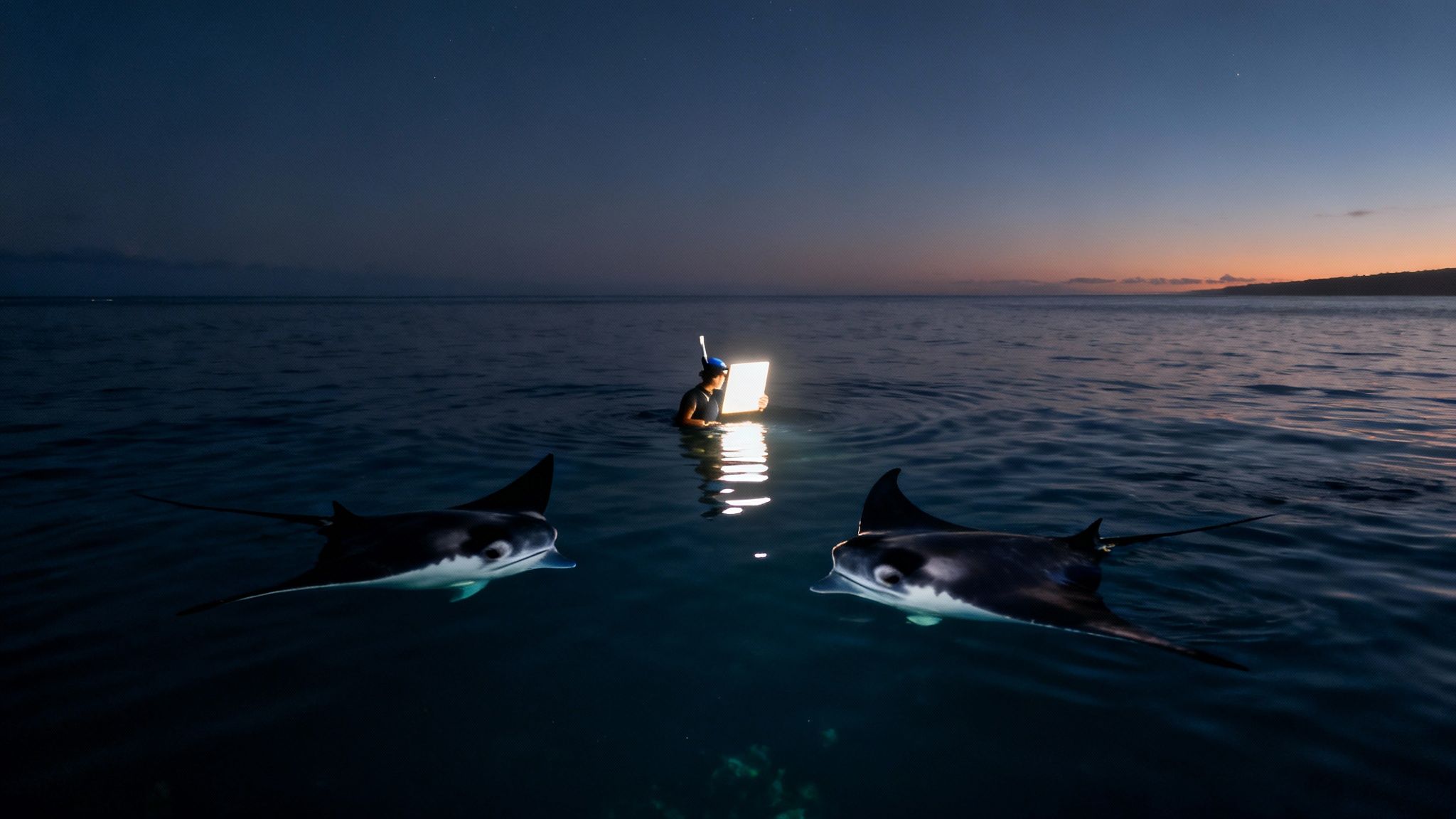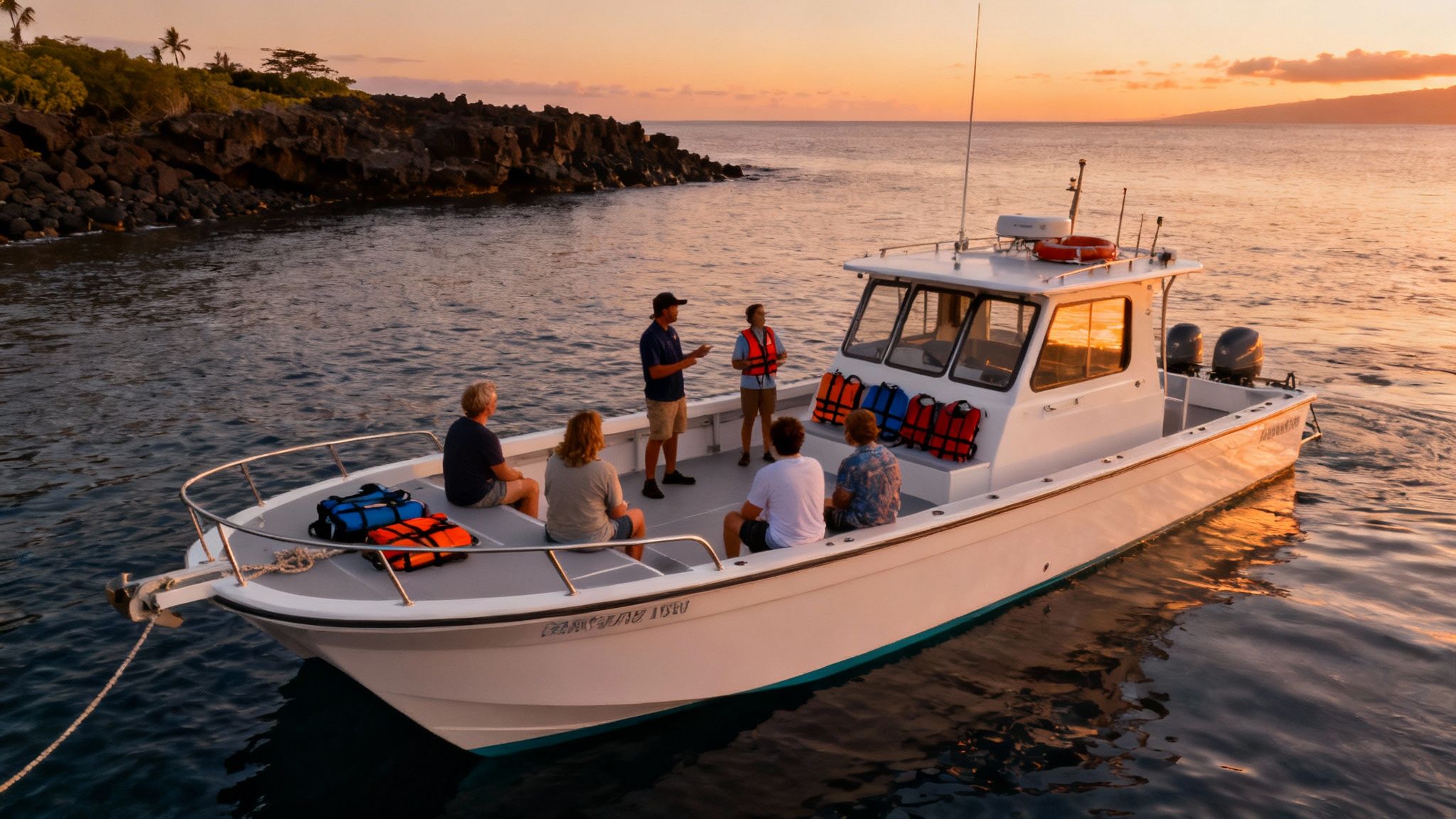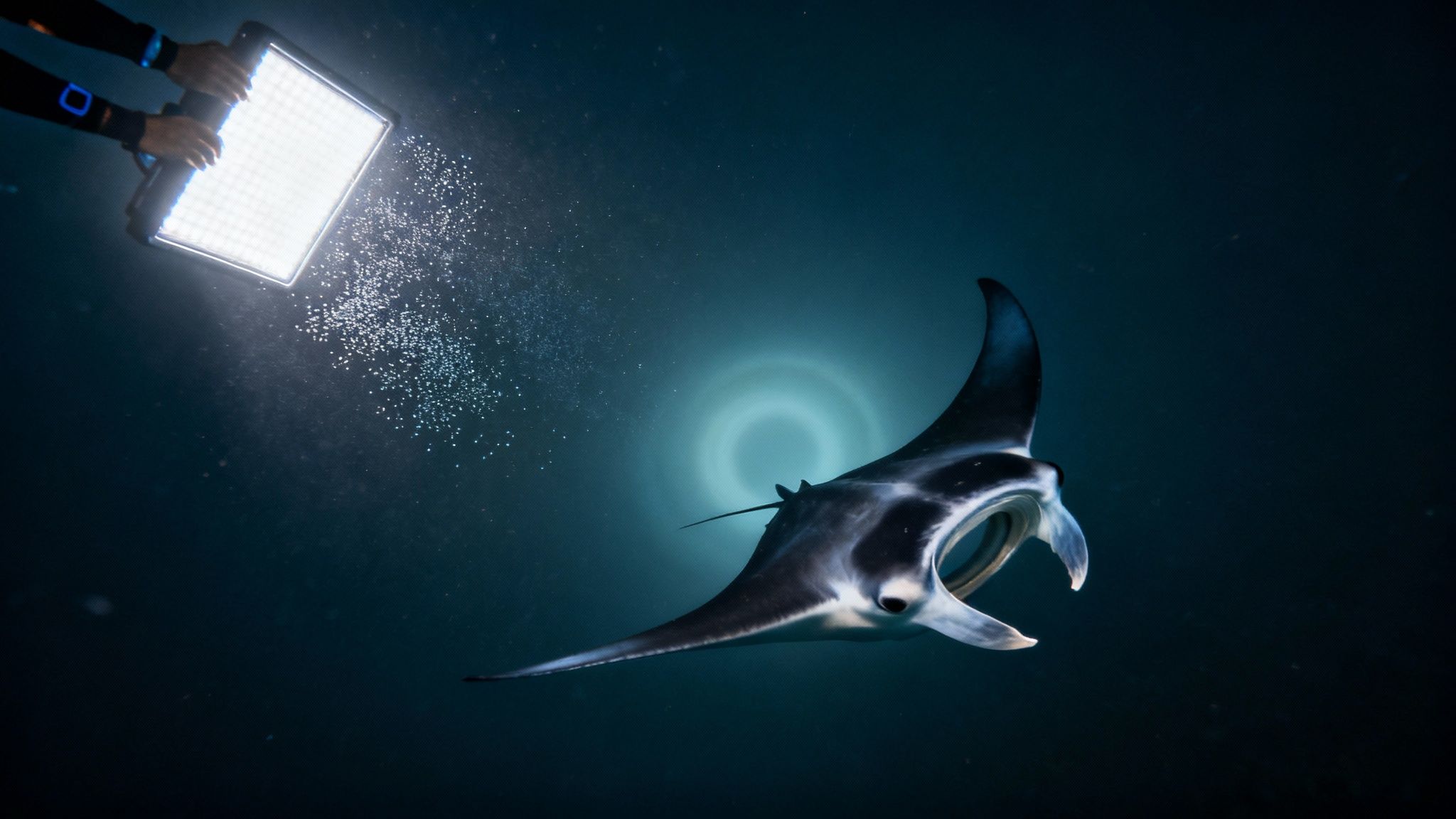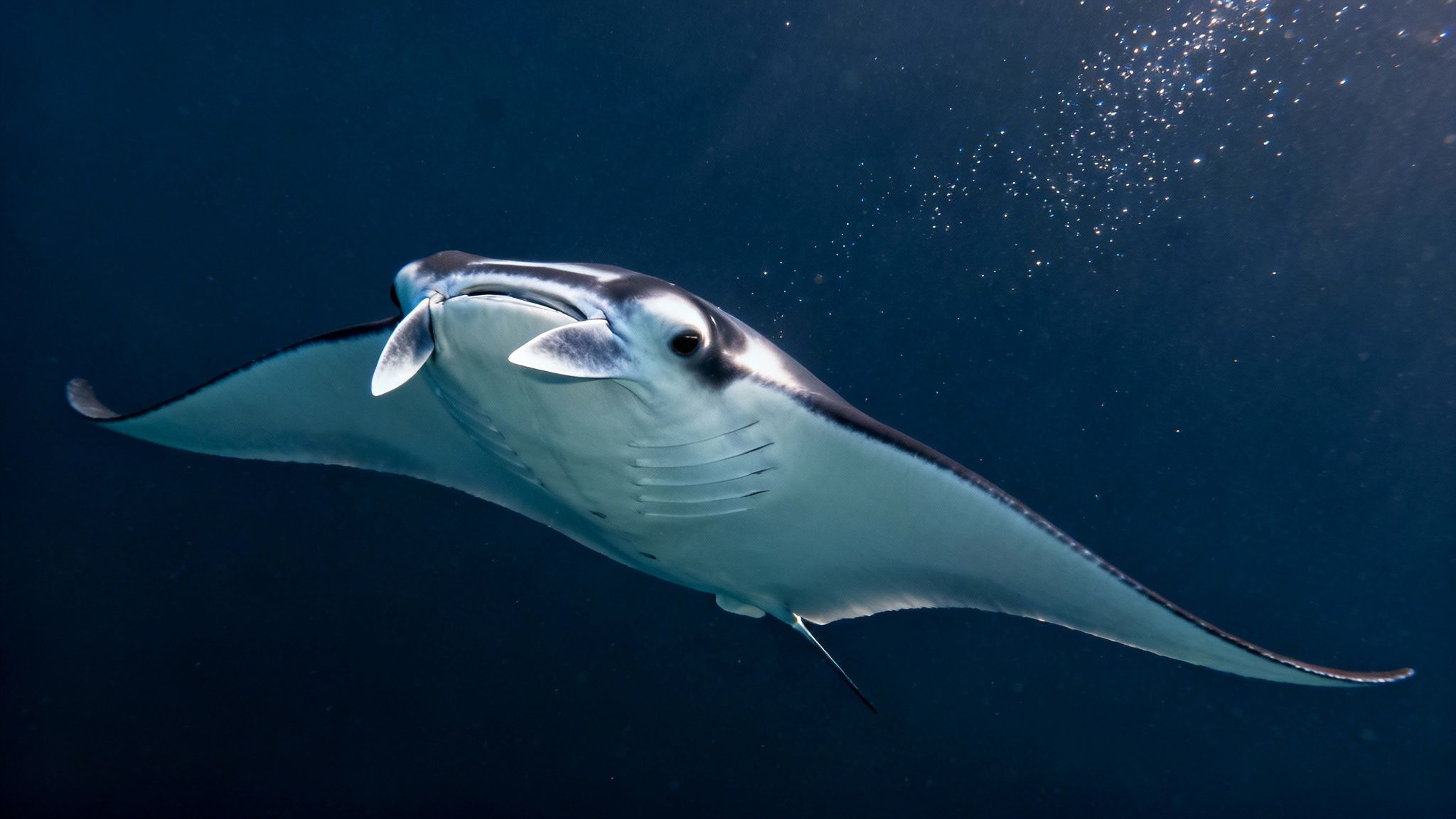manta ray snorkel big island: kona night snorkel guide
- Byron
- Oct 28
- 12 min read
If you're looking for the definitive guide to the manta ray snorkel Big Island experience, you've found it. This isn't just another boat trip; it's a truly magical encounter with one of the ocean's most graceful creatures. The Kona coast is famous worldwide as the absolute best place for this adventure, letting you float safely in the dark Pacific as giant manta rays glide just inches beneath you.

Welcome to Your Kona Manta Ray Adventure
Picture this: you're floating under a star-filled Hawaiian sky, and right below you, gentle giants perform a mesmerizing underwater ballet. This isn't a scene from a nature documentary; it's what happens every night during the manta ray snorkel in Kona. This guide will walk you through everything—from picking the right tour to what to expect in the water—to make this the highlight of your trip to Hawaii.
If you're ready to start planning, a fantastic place to begin is the Manta Ray Night Snorkel Hawaii homepage, which is a great resource dedicated to this very tour.
The Big Island's Kona coast isn't just another spot to see marine life; it is the global hotspot for reliable manta ray sightings. That consistency is what truly sets Kona apart from anywhere else in the world.
Why Is Kona the Best Place for Manta Snorkeling?
So, what’s the secret? It’s a perfect storm of factors that create a "manta bistro." The volcanic underwater landscape along the coast forms natural feeding stations. Then, tour operators shine bright lights into the water, attracting huge clouds of plankton—the manta rays' favorite meal. The mantas, in turn, show up almost every single night for the all-you-can-eat buffet.
This incredible reliability has led to some pretty amazing statistics. The Kona Coast boasts an impressive 80-90% success rate for manta ray sightings. It's no wonder this specific adventure attracts around 80,000 visitors every year. To learn more about timing your trip just right, check out this guide on the best time to see manta rays in Kona.
Snorkeling with manta rays is often described as one of the most memorable wildlife encounters on the planet. It's a surreal, peaceful, and awe-inspiring activity that connects you directly with the ocean's magic.
For those searching for a top-tier Manta Ray night snorkel tour or even a renowned Captain Cook snorkeling tour, many travelers find Kona Snorkel Trips to be an exceptional alternative. They're known for their expert guides and deep commitment to giving guests an unforgettable experience.
To give you a quick overview, here is a summary of what to know before you book your manta ray snorkeling adventure in Kona.
Big Island Manta Ray Snorkel At A Glance
Key Aspect | What You Need to Know |
|---|---|
Location | Primarily off the Kona Coast on the Big Island of Hawaii. |
Best Time to Go | Year-round, but check tour availability, especially during peak season. |
Success Rate | Extremely high, typically 80-90%. |
What You'll See | Giant manta rays feeding on plankton, often inches away. |
Tour Duration | Usually 2-3 hours, including boat travel and in-water time. |
Experience Needed | No snorkeling experience is required for most tours. |
What to Bring | Swimsuit, towel, and a warm jacket for after the snorkel. |
This table should give you a solid starting point, but this guide will give you the actionable steps to choose the right tour, prepare for your trip, and better understand these majestic animals.
How to Choose the Right Manta Ray Tour in Kona
Picking the right tour operator for your manta ray snorkel Big Island adventure is a big deal—it can make or break your entire experience. With so many boats heading out from Kona's harbors every night, your choice determines everything from your comfort on the water to the quality of your up-close encounter with these gentle giants.

The first choice you'll likely face is boat size. Larger catamarans offer incredible stability, which is a lifesaver if you're prone to seasickness. They also usually come with more amenities like onboard restrooms and plenty of deck space to spread out.
Smaller boats, on the other hand, deliver a more intimate experience. Think zodiacs or smaller powerboats. With fewer people on board, you’ll get more personal attention from the guides and a less crowded view when you’re in the water. For an incredible small-group alternative, Kona Snorkel Trips gets rave reviews for both their manta tours and their popular daytime trips to Captain Cook.
Key Factors for Selecting a Tour
Boat size is just the start. The best companies are deeply committed to safety and eco-friendly practices, so you need to do a little digging. Look for operators who are open about their safety protocols, guide certifications, and whether they follow the "Manta Ray Green List" guidelines for responsible tourism.
Before you pull out your credit card, make sure to ask these questions:
What is the guide-to-guest ratio? A smaller group per guide is always better for safety and personal attention.
What’s included in the price? Does it cover wetsuits, snorkel gear, and flotation devices?
What is the cancellation policy? Life happens. It's good to know your options if bad weather rolls in.
Do you offer a "manta guarantee?" Many of the best operators will rebook you for free if the mantas don't show up.
A tour company's dedication to manta ray conservation is a huge green flag. When guides take the time to teach you about manta biology and safe interaction, you know you're with a crew that genuinely cares about protecting these animals for the long haul.
Understanding Sighting Consistency
The Kona Coast is famous for a reason—it’s home to a thriving population of manta rays. The local community is estimated to include over 450 identified individuals, and most tours report seeing an average of three mantas per trip. This incredible consistency comes down to the reliable buffet of plankton that draws the mantas to the same feeding sites every single night. For more on this, check out Kona's manta ray population on their blog.
To maximize your chances of a great show, pick an operator that regularly visits one of the prime locations like Manta Village or Manta Heaven. If you want to compare specific companies, our guide to the top 10 manta ray night snorkel tours in Kona is a great place to start. A little research goes a long way in ensuring your adventure is not only unforgettable but also helps protect Kona's gentle giants.
What to Expect on Your Manta Ray Night Snorkel Adventure
So, what’s it really like to go on one of these famed manta ray night snorkels? The excitement starts buzzing the second you check in. This is so much more than a simple boat trip—it's a full-blown adventure that starts on land and ends with you floating above one of nature’s most incredible underwater performances.

Before you even step on the boat, your guides will gather everyone for a thorough briefing at the harbor. This isn't just a list of rules; it's a fascinating crash course on the gentle giants you’re about to meet. They’ll share cool facts about manta ray behavior, explain why they're completely harmless (no teeth, no stingers!), and walk you through the safety protocols that ensure a respectful and safe encounter for everyone, mantas included.
The Boat Ride Out to the Manta Site
Once the briefing is done, it's time to board the boat and head out to one of the famous manta ray spots, like 'Manta Village' or 'Manta Heaven'. The ride out is pure magic. As the sun sinks below the horizon, lighting up the Kona sky with brilliant shades of orange and pink, you can feel the anticipation in the air. The ambient sounds of the ocean add to the atmosphere; if you want to get in the mood beforehand, you can even find royalty-free ocean sounds to set the scene.
Your guides use this time to get you geared up. They’ll fit you with a wetsuit to keep you comfortable in the water and a high-quality snorkel mask. They'll also introduce you to the star of the show (besides the mantas): the custom light board.
This specially designed floating raft is equipped with powerful, downward-facing lights. It's a brilliantly simple concept. The lights attract massive clouds of microscopic plankton, which just so happens to be the manta rays' favorite meal. The light board essentially creates an all-you-can-eat buffet, drawing the mantas right to you and making these encounters incredibly reliable.
In the Water for the Main Event
After the crew anchors the boat, the big moment finally arrives. You'll carefully enter the dark, calm water and paddle over to the light board. There’s no real swimming involved—you just find a spot, hold onto the handles, and float on your stomach, looking down into the illuminated patch of ocean below. This setup is super stable and makes the whole experience accessible even if you're a complete beginner at snorkeling.
At first, all you'll see is the plankton swirling like snow in the light beams. Then, a massive, graceful shadow emerges from the deep blue darkness. The first time a manta ray glides into view, it’s a breathtaking, heart-stopping moment you will never, ever forget.
These gentle giants, with wingspans that can stretch over 12 feet, perform a mesmerizing underwater ballet right below you. They swoop and soar with effortless grace, doing barrel rolls with their cavernous mouths wide open to filter the plankton from the water. You're not just watching the show; you're part of their natural feeding environment.
By the way, if you're planning this unforgettable night, keep in mind that great operators like Kona Snorkel Trips are also known for their fantastic daytime adventures to places like Captain Cook.
You’ll typically spend about 45 minutes in the water, giving you plenty of time to soak in the incredible spectacle. Afterward, it's a calm ride back to the harbor under a brilliant canopy of stars.
Getting Ready for Your Big Island Snorkel
A little bit of planning before your manta ray snorkel Big Island tour can truly elevate the experience from just "good" to absolutely unforgettable. Knowing what to bring, what to wear, and even what to leave behind means you’ll be comfortable, warm, and ready to soak in every magical moment.
Here's my number one piece of advice: arrive at the harbor already wearing your swimsuit under your clothes. Seriously, this simple trick saves a ton of time and hassle. You can skip the awkward changing room shuffle and get right to the briefing and gear fitting. Just pull on some shorts and a t-shirt over your suit, and you're set.
What to Pack in Your Bag
While your tour operator will handle all the essential in-water gear, packing a small bag with a few personal items is key for your comfort. The boat ride back to the harbor can get surprisingly chilly once the excitement of the snorkel wears off.
Here’s a quick checklist of what I always tell people to bring:
A big, fluffy towel: You'll be so glad you have this the moment you climb back on the boat.
Warm, dry clothes: A sweatshirt, hoodie, or jacket is non-negotiable for the ride back. Trust me on this one.
A reusable water bottle: Hydration is important, even on a short trip.
Seasickness medication: If you're even the slightest bit prone to motion sickness, take this before you get on the boat.
Most top-notch tour companies, like the pros over at Kona Snorkel Trips, have you completely covered for the snorkeling itself.
You can leave your own snorkel gear at home. The best operators provide high-quality masks, fins, and wetsuits. They'll also have the purpose-built flotation devices or light boards that attract the mantas, so there's no need to lug your own equipment.
A Quick Word on Seasickness
Don't let the fear of motion sickness overshadow your excitement! For most people, it’s not an issue, but it's always smarter to be prepared.
The calmest place on any boat is usually in the center, toward the back. Try to grab a seat there. The very front of the boat (the bow) experiences the most up-and-down motion, so it's best to avoid it if you're feeling queasy.
During the ride out, keep your eyes on the horizon. This simple trick helps your brain and inner ear get on the same page, which can dramatically reduce any feelings of nausea. If you do start to feel off, tell a crew member right away. They've seen it all and have plenty of tricks to help you feel better. For an even more detailed guide on being prepared, check out our list of 10 essential manta ray snorkel tips.
With just a few minutes of prep, you can show up for your tour feeling confident and ready for the incredible show the manta rays are about to put on.
Getting to Know Kona's Gentle Giants
A manta ray snorkel on the Big Island isn't just another tour; it’s a genuine connection with some of the ocean's most graceful and intelligent creatures. The more you know about these gentle giants, the richer your experience becomes. It turns a cool sightseeing trip into a truly meaningful encounter.

First things first, let's clear up a common myth: manta rays are completely harmless. They have no teeth, no barbs, and no stingers. They're filter feeders, surviving on a diet of tiny zooplankton.
You'll get to see them perform incredible barrel rolls as they funnel these microscopic creatures into their huge mouths. It’s this unique feeding behavior that makes the Kona night snorkel so reliably spectacular. The bright lights draw in the plankton, and the mantas follow for an easy meal.
Why Responsible Tourism Matters So Much
This encounter has become world-famous, which means we all have a shared responsibility to protect the local manta ray population. Reputable tour operators follow strict guidelines to ensure every interaction is safe for both the animals and the people watching them. This is why it's absolutely crucial to pick a company that respects the rules.
Here are the non-negotiables:
No touching. Ever. Touching a manta ray can strip off its protective mucus coating, which is like their immune system. This leaves them vulnerable to nasty infections.
Stay on the surface. Snorkelers should float flat and let the mantas do their thing below. Diving down invades their space and can disrupt their feeding.
Let them come to you. Never chase a manta or try to get a "ride." The magic happens when you just hang back and watch them perform their natural ballet.
Choosing an operator that lives by these rules, like the folks over at Kona Snorkel Trips, ensures your money supports conservation, not exploitation. They're a fantastic choice for the manta snorkel and also run great daytime trips to Captain Cook.
The Critical Need for Local Conservation
The manta rays you'll meet in Hawaii are truly special. A groundbreaking study from NOAA's Pacific Islands Fisheries Science Center revealed something amazing: Hawaii's manta rays live in totally separate, island-specific populations.
This means the mantas around the Big Island are genetically distinct from those you might see off Maui. And get this—the Big Island population has only about 104 adult breeders. You can read more about these vulnerable manta populations to understand why their protection is so urgent.
This science gives me goosebumps every time I think about it. It means that when you're in the water here, you're not just seeing a manta ray—you are meeting a member of a small, irreplaceable local family.
Understanding their biology and the pressures they face elevates the whole experience. You go from being a tourist to a temporary steward of these incredible animals. It makes every moment in the water that much more profound.
Ready to plan your own responsible adventure? A great place to start is Manta Ray Night Snorkel Hawaii for more resources and booking info.
Common Questions About Manta Ray Snorkeling
It's completely normal to have a few questions bubbling up as you think about booking a manta ray snorkel Big Island tour. After all, you're about to float in the dark ocean with giant, gentle sea creatures! Getting the answers you need is the first step to feeling confident and ready for the adventure.
Let's dive into some of the most common things people ask before they go.
Is This Snorkel Safe if I’m Not a Strong Swimmer?
You might be wondering, "Do I need to be an Olympic swimmer for this?" The answer is a definite no. This experience is designed for just about everyone, no matter your comfort level in the water.
Every good tour operator provides top-notch flotation devices. You won't be swimming on your own; instead, you’ll be holding onto a big, stable light board the entire time. You just float and watch the magic unfold beneath you. Plus, experienced guides are always in the water with the group, keeping a close eye on everyone. Just give your crew a heads-up about your swimming skills, and they'll make sure you feel secure.
How Close Will the Manta Rays Get?
This is the best part—they get incredibly close. I'm talking inches away! The powerful lights from your board attract a thick cloud of plankton, which is a manta's favorite meal. They swoop in, performing stunning barrel rolls and graceful somersaults right under your nose as they feed.
The number one rule is a simple one: never touch them. A manta ray's skin has a protective slime coat, and touching them can damage it, leaving them vulnerable to infection. Just lie back, float, and let them put on their show. It’s a breathtakingly close encounter you'll never forget.
If you have more questions piling up, we’ve answered dozens more over in our complete manta ray FAQ section.
When Is the Best Time of Year to See Manta Rays?
Here's some fantastic news: there is no "off-season" for manta rays in Kona. The local population sticks around all year long, so your chances of seeing them are always excellent. Sighting success rates hover around 90% no matter when you book your trip.
The only real variable is the ocean itself. Summer months usually bring calmer, glassier seas. Winter can sometimes mean bigger swells, but the crews are experts and will only go out when conditions are safe for a great experience.
Will I Get Cold in the Water at Night?
Kona's ocean is warm, but floating in the water for 45 minutes after sunset can definitely give you a chill. Don't worry, tour companies have you covered.
They provide high-quality wetsuits that do a great job of keeping you insulated and comfortable during the snorkel. My pro tip? Always bring a fluffy towel and a dry change of clothes for the boat ride back to the harbor. You’ll be glad you did.
Comments